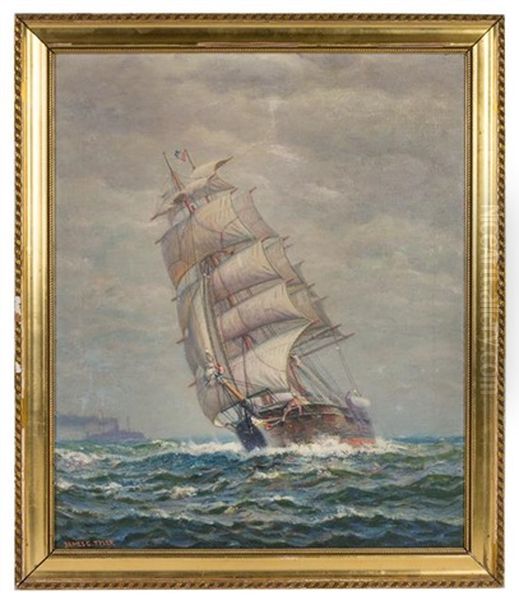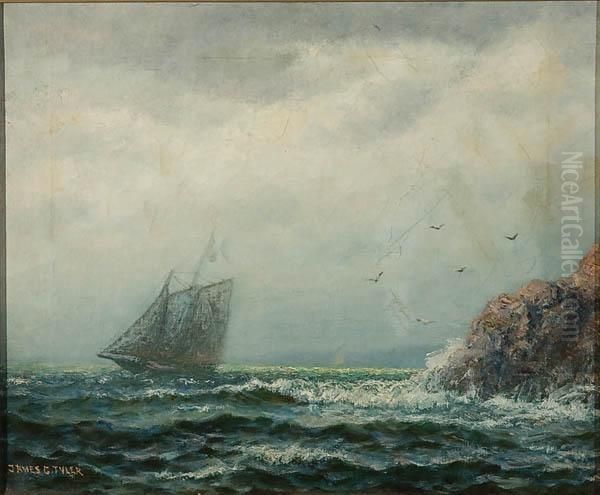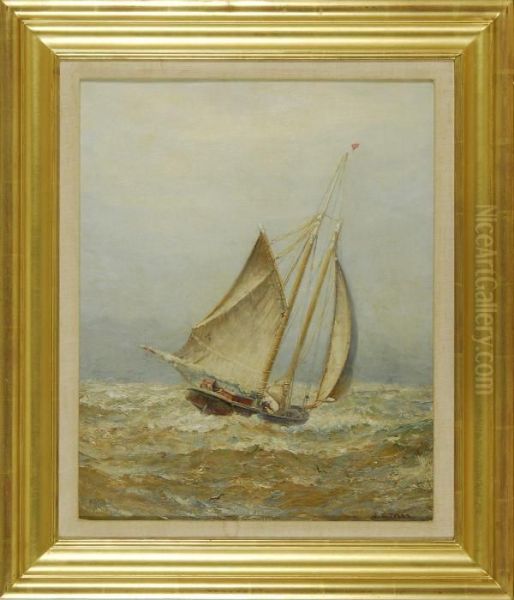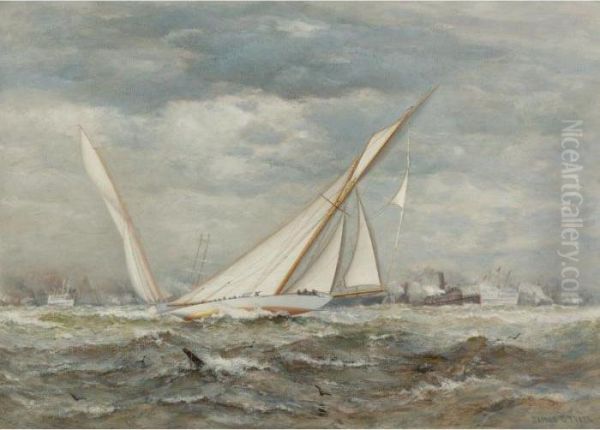James Gale Tyler (1855-1931) stands as a significant figure in American art history, celebrated primarily for his evocative and atmospheric marine paintings and illustrations. Throughout a prolific career spanning the late nineteenth and early twentieth centuries, Tyler captured the dynamic spirit of the sea and the vessels that navigated its waters. His work, deeply rooted in the maritime culture of the American East Coast, resonated with a public fascinated by seafaring life, naval power, and the burgeoning sport of yacht racing. Tyler's distinct style, combined with his keen observational skills, made him one of the most recognized and popular marine artists of his era.
Early Life and Artistic Formation
Born in Oswego, New York, in 1855, James Gale Tyler's connection to the water likely began early, given his upbringing near Lake Ontario. However, his professional artistic journey commenced when he moved to New York City around 1870. The bustling metropolis, a major international port and a burgeoning center for the arts, provided fertile ground for the young artist's ambitions. It was here that Tyler sought formal instruction, albeit briefly.
His only recorded period of formal training was under Archibald Cary Smith. Smith was not only an artist but also a noted naval architect, a background that undoubtedly provided Tyler with valuable insights into the structure and mechanics of ships. This technical understanding, even if briefly studied, likely complemented Tyler's innate artistic talent. Despite this short tutelage, Tyler is largely considered a self-taught artist. He honed his skills through dedicated practice, observation, and an immersive engagement with his chosen subject matter – the sea and the ships that sailed upon it. His rapid development suggests a natural affinity for marine themes and a determined pursuit of his craft.
Developing a Distinctive Style
James Gale Tyler forged an artistic style characterized by its vividness, poetic sensibility, and strong sense of individuality. Unlike some marine painters who prioritized meticulous, almost photographic accuracy in ship portraiture, Tyler was more concerned with capturing the mood, atmosphere, and emotional resonance of a scene. His approach focused on the interplay of light and shadow, the movement of water, and the overall feeling evoked by the maritime environment.

His paintings often feature subtle yet effective light effects, whether it's the glint of sunlight on a wave, the soft glow of moonlight on sails, or the dramatic contrasts of a storm-tossed sea. This emphasis on luminosity and atmosphere contributed significantly to the popularity of his work during his lifetime. Critics and collectors were drawn to the evocative power of his canvases, which seemed to convey the very essence of maritime life rather than just its surface details.
Interestingly, Tyler's style has sometimes been compared to that of Albert Pinkham Ryder, another American painter known for his moody, atmospheric, and often enigmatic seascapes. While their techniques and ultimate visions differed, the comparison highlights Tyler's departure from strict realism towards a more expressive and personal interpretation of the marine world. He sought to convey the poetry and drama inherent in his subjects.
New York City: Hub of a Career
New York City served as the central hub for James Gale Tyler's long and successful career. After arriving around 1870 and undertaking his brief study with Archibald Cary Smith, Tyler established himself within the city's vibrant art scene. New York, with its major harbor, constant maritime traffic, and wealthy patrons interested in yachting and naval subjects, was the ideal location for a specialist marine painter.
He maintained a studio in the city for many years, immersing himself in the maritime life that unfolded around him. The docks, the bay, and the nearby Long Island Sound offered endless inspiration. Furthermore, New York provided access to major galleries, art associations, and publications, which were crucial for building a reputation and securing commissions. His presence in the city allowed him to connect with fellow artists, collectors, and critics, fostering his professional development.
The city's role as a media center also proved beneficial. Tyler's ability to secure illustration work with prominent New York-based magazines like Harper's and Century significantly broadened his reach and public recognition, reinforcing his status as a leading marine artist based in the nation's artistic capital. His primary sphere of activity remained anchored in New York and its environs, including frequent trips to coastal New England.
The Allure of the Sea: Subject Matter
James Gale Tyler dedicated his artistic life almost exclusively to marine subjects. His oeuvre encompasses a wide range of maritime themes, reflecting both the historical significance and contemporary fascination with the sea. He painted various types of vessels with great skill and understanding, demonstrating a comprehensive knowledge of nautical design and history.

His subjects included the majestic clipper ships of the mid-nineteenth century, capturing the romance and speed of the age of sail, as seen in works like Clipper Nearing Port. He depicted sturdy schooners, coastal craft, and working boats, showcasing the everyday life of mariners. Tyler also embraced modernity, painting steamships and contemporary naval vessels, reflecting the technological transitions occurring during his lifetime.
Yachting, particularly the prestigious America's Cup races, became a recurring and important theme in his work. His paintings captured the elegance and excitement of these sleek racing machines. Beyond the vessels themselves, Tyler masterfully rendered the ocean in its many moods – from tranquil, sunlit waters to dramatic, storm-lashed waves. Works like Yachts, Jelly Fish suggest an interest not just in the ships but in the broader marine environment. His ability to depict water, sky, and light convincingly was central to his art's appeal.
Chronicler of the America's Cup
James Gale Tyler earned particular renown as a painter of the America's Cup yacht races. Starting possibly as early as the 1890s and certainly consistently from 1900 until 1930, Tyler made annual trips to Newport, Rhode Island, the traditional venue for the Cup races during that era. These events were major spectacles, attracting international attention and embodying national pride and technological prowess.
Tyler immersed himself in the atmosphere of the races, sketching and observing the competing yachts, the surrounding spectator fleets, and the coastal setting. He translated these observations into dynamic and evocative paintings that captured the speed, grace, and competitive tension of the regattas. His works often featured famous defenders like Columbia, Reliance, and Resolute, and challengers such as Sir Thomas Lipton's Shamrock series.
These America's Cup paintings were highly sought after and widely reproduced, appearing as illustrations in popular magazines of the day, including Literary Digest, Harper's, and Century. This regular exposure cemented Tyler's reputation as the preeminent visual chronicler of America's most famous yachting event. His dedication to this subject over several decades created a unique and valuable artistic record of the Cup's golden age.
Illustrator and Writer
Beyond his work as a painter of easel pictures, James Gale Tyler was also a successful and prolific illustrator and occasional writer. His skills in depicting maritime scenes were in high demand by leading periodicals of the late 19th and early 20th centuries. He contributed illustrations to widely circulated magazines such as Harper's Weekly, The Century Magazine, and Literary Digest.

These illustrations often accompanied articles on naval affairs, historical sea voyages, yacht races (especially the America's Cup), or fictional sea stories. His ability to create compelling and accurate visual narratives made his work highly valued by editors and readers alike. In an era before widespread photography, illustrations were crucial for conveying news and stories, and Tyler excelled at bringing maritime subjects to life on the printed page.
The source material also indicates that Tyler occasionally wrote articles, likely related to his area of expertise – the sea and ships. This dual role as both artist and writer further solidified his position as an authority on maritime matters within the cultural landscape of his time. His contributions to these popular magazines significantly enhanced his visibility and reputation beyond the confines of the traditional art exhibition world.
Exhibitions and Recognition
Throughout his career, James Gale Tyler actively exhibited his work, gaining recognition through participation in shows at prestigious institutions and membership in key art organizations. His paintings were frequently seen in New York City at the National Academy of Design, a major venue for American artists, and the Brooklyn Art Association. He also exhibited further afield, including at the Pennsylvania Academy of the Fine Arts in Philadelphia.
His reputation extended beyond the Northeast. His works were displayed at the Corcoran Gallery of Art in Washington, D.C., indicating national recognition. Furthermore, his paintings found homes in specialized collections focused on maritime history, such as the Mariner's Museum (then associated with the New-York Historical Society) and within the holdings of the Yale University Library.
Tyler's active participation in the art world included joining several art organizations, which provided platforms for exhibition and professional networking. While perhaps not achieving the highest academic honors like full membership in the National Academy, his consistent presence in major exhibitions and the acquisition of his work by notable institutions underscored his standing as a respected professional artist. His popularity with the public and collectors was undeniable.
The Forgery Controversy
A testament to James Gale Tyler's popularity and the market value of his work in the late nineteenth century is the unusual circumstance of widespread forgery. It was reported that at one point, over one hundred paintings were circulating in New York City falsely attributed to him. This situation, while problematic for the artist, highlighted the strong demand for his signature style and subject matter.

The existence of numerous fakes suggests that Tyler's name carried significant weight in the art market. Unscrupulous dealers or artists were clearly attempting to capitalize on his reputation by passing off inferior works as genuine Tylers. This level of forgery indicates that his paintings commanded good prices and were readily saleable.
Tyler did not passively accept this situation. He took action to protect his reputation and livelihood. He reported the matter to the local District Attorney, indicating the seriousness with which he viewed the fraud. Furthermore, he pursued civil litigation against those involved in creating or selling the forgeries. His success in these legal actions demonstrated his determination to uphold the authenticity of his work and likely served as a deterrent against future attempts at forgery. This episode reveals both the high regard in which Tyler's art was held and his willingness to defend his artistic identity.
Artistic Context and Contemporaries
James Gale Tyler worked during a dynamic period in American art, bridging the late Hudson River School's luminist tendencies, the rise of Tonalism and Impressionism, and the enduring appeal of Realism. As a marine specialist, he operated within a rich tradition of American maritime painting while developing his own distinct voice.
His focus on mood and light aligns him loosely with Tonalist painters like Albert Pinkham Ryder, George Inness, and Ralph Albert Blakelock, who prioritized atmosphere over precise detail. However, Tyler's work generally maintained a greater degree of representational clarity than Ryder's often mystical canvases. His teacher, Archibald Cary Smith, grounded him in the realities of naval architecture.
He was a contemporary of other major American artists who depicted the sea, though often with different approaches. Winslow Homer brought a powerful, dramatic realism to his marine subjects. William Trost Richards was known for his highly detailed coastal scenes and waves. Edward Moran, part of the famous Moran artistic family, was another prominent painter of seascapes and historical naval scenes. Thomas Eakins, while primarily a figure painter, created iconic rowing and sailing scenes on the Schuylkill and Delaware Rivers.
Other marine specialists active during or overlapping with Tyler's career include Antonio Jacobsen, a prolific painter of ship portraits known for his accuracy, and Frederic Schiller Cozzens, another well-regarded illustrator and painter of yachting scenes, including the America's Cup. Impressionists like Childe Hassam also painted coastal scenes, focusing on light and color in a different manner than Tyler. Even earlier figures associated with Luminism, such as Sanford Robinson Gifford and John Frederick Kensett, explored effects of light on water, providing a backdrop against which Tyler's work can be viewed. James McNeill Whistler's tonal nocturnes also explored atmospheric effects, particularly in waterside settings. Tyler navigated these various artistic currents, creating a body of work that was both popular in its time and enduring in its appeal.
Notable Works and Themes
While identifying a single definitive masterpiece can be challenging for a prolific artist like James Gale Tyler, several works and recurring themes stand out. His painting Clipper Nearing Port exemplifies his skill in capturing the grandeur of the age of sail, likely depicting a majestic vessel returning from a long voyage, sails catching the light as it approaches land. This theme resonated with nostalgia for the era of great sailing ships.
Craft of 1850 suggests an interest in historical maritime subjects, perhaps depicting a specific type of vessel common in the mid-nineteenth century, showcasing his knowledge of nautical history. The title Yachts, Jelly Fish is intriguing, hinting at a composition that combines the elegance of pleasure craft with observations of marine life, suggesting a broader engagement with the ocean environment beyond just the ships themselves.
However, Tyler is arguably most famous for his extensive series of America's Cup paintings. These works, created over three decades, form a cohesive and significant part of his legacy. They capture the dynamism and elegance of racing yachts like Reliance, Columbia, and their challengers. These paintings are characterized by their depiction of speed, the dramatic lean of the yachts under sail, the spray of the water, and the specific light and weather conditions of the race day. They are not just portraits of boats, but vivid snapshots of maritime competition at its highest level. His consistent ability to convey the excitement and beauty of these events cemented his reputation.
Later Life and Legacy
James Gale Tyler remained active as an artist well into the twentieth century. He continued to paint maritime subjects and notably maintained his connection to the America's Cup, documenting the races until 1930, just a year before his death. His dedication to his chosen field was lifelong. He passed away in Pelham Manor, New York, in 1931, leaving behind a substantial body of work.
Tyler's legacy rests on his position as one of America's foremost marine painters of his generation. He successfully captured the transition from sail to steam and chronicled the golden age of American yachting with unparalleled dedication. His ability to blend accurate observation with atmospheric and poetic interpretation made his work accessible and appealing to a broad audience.
His paintings are held in numerous public and private collections, including maritime museums, historical societies, and art galleries. Institutions like the Mariner's Museum, the New-York Historical Society, and others preserve his contributions to American art and maritime history. Through his paintings and illustrations, James Gale Tyler provided a lasting visual record of America's enduring relationship with the sea, ensuring his place as a significant chronicler of the nation's maritime spirit.
Conclusion
James Gale Tyler carved a distinct and respected niche within American art as a dedicated and talented marine painter and illustrator. From his early self-directed studies, guided briefly by Archibald Cary Smith, he developed a style that emphasized mood, light, and the dynamic energy of the sea. Based primarily in New York City, he drew inspiration from the bustling harbor and the nearby coastlines, becoming particularly famous for his decades-long artistic documentation of the America's Cup races. His work for popular magazines broadened his reach, while his successful defense against forgery underscored his professional standing. As a contemporary of artists ranging from Winslow Homer to Albert Pinkham Ryder, Tyler navigated the artistic currents of his time to create a popular and enduring body of work that continues to evoke the power and allure of the maritime world.